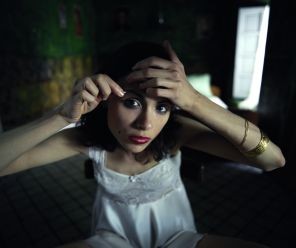Zarin

Nothing quite wakes me up to the pains and perversions of our world like a visit to the Stedelijk Museum. Amsterdam's museum of modern art is both beautiful and disturbing in its complex abstractions of the way it looks, the way it feels, to live and move and breathe and be in today's society.
I used to be repulsed by "modern art" -- or at least skeptical and confused... and definitely unappreciative. Yet ironically, even as I've gained an appreciation for modern art through my visits to the Stedelijk Museum, I am still often confused by the art (and I would be especially so if I were not afforded the benefits of explanatory placards). I am still skeptical of the artists' messages (if not their media). And truthfully, I am still repulsed and haunted by the images and emotions from within the Stedelijk Museum.
I see their beauty. I appreciate their meaning. Yet I am disturbed by their reality.
Today I was most profoundly affected by the art of an Iranian-American filmmaker named Shirin Neshat. In particular, Neshat's short film, "Zarin" haunted me with its graphic depiction of the metaphysical effects of sin and guilt. The museum's description of the piece is as follows:
This latest film by Neshat, recently shot in Morocco, chronicles the emotional and psychological breakdown of a young woman, Zarin, who has been working as a prostitute in an Iranian brothel since childhood. One day, as she attends to one of her clients, it seems he no longer has a face. From that moment on, every client appears to her faceless. Overcome with feelings of horror and shame, she believes she has been struck by God’s punishment: she has gone mad. She flees the brothel to seek redemption. Going to the hammam (public bath), she washes and scrubs her body until it bleeds, but as she emerges from the hammam she discovers that all the men in the street remain faceless. Frantically finding her way to a mosque, she begins to fervently pray, in the hope that God will forgive her for her indiscretions.Honestly, I found the film to be very disturbing. Very raw and direct. Not a good date movie (in case you were wondering). However, "Zarin" was truly meaningful, because it visually expressed a very real human struggle. Not just the struggle of an Iranian prostitute being haunted by faceless men because of her lifestyle's contrast with the predominant Muslim culture -- but the struggle of an imperfect person losing the connection and context of life because of her sin and the sin of her culture.
Zarin sought to escape sin through changing her environment (leaving the brothel, wandering the streets of Tehran). Zarin sought to escape sin through changing the cast of characters (looking for faces among the strangers on the street, the fruit vendor, the kneeling men at the mosque). Zarin sought purification through secular rituals (the bathhouse). Zarin sought purification through religious rituals (the mosque). Zarin lashed out at people who tried to help her (the old lady offering to wash her back at the bathhouse). Zarin found herself doomed to a life of running.
And of course the reason that all of this is so disturbing is that I see Zarin everyday. Zarin is everyone. Zarin is me.
What a wretched man I am! Who will rescue me from this body of death? Thanks be to God -- through Jesus Christ our Lord! (see Romans 7). I suspect that this may not be the conclusion to which Shirin Neshat was pointing her audience. But that's the miracle of modern art, isn't it? Meaning is defined by the audience's interaction with the art. And I, for my part, cannot escape this conclusion.


0 Comments:
Post a Comment
<< Home